The Biostar X370GTN Mini-ITX Motherboard Review: AM4 Goes Tiny
by Gavin Bonshor on October 23, 2017 9:00 AM ESTSystem Performance
Not all motherboards are created equal. On the face of it, they should all perform the same and differ only in the functionality they provide - however this is not the case. The obvious pointers are power consumption, but also the ability for the manufacturer to optimize USB speed, audio quality (based on audio codec), POST time and latency. This can come down to manufacturing process and prowess, so these are tested.
Power Consumption
Power consumption was tested on the system while in a single ASUS GTX 980 GPU configuration with a wall meter connected to the Thermaltake 1200W power supply. This power supply has ~75% efficiency > 50W, and 90%+ efficiency at 250W, suitable for both idle and multi-GPU loading. This method of power reading allows us to compare the power management of the UEFI and the board to supply components with power under load, and includes typical PSU losses due to efficiency. These are the real world values that consumers may expect from a typical system (minus the monitor) using this motherboard.
While this method for power measurement may not be ideal, and you feel these numbers are not representative due to the high wattage power supply being used (we use the same PSU to remain consistent over a series of reviews, and the fact that some boards on our test bed get tested with three or four high powered GPUs), the important point to take away is the relationship between the numbers. These boards are all under the same conditions, and thus the differences between them should be easy to spot.
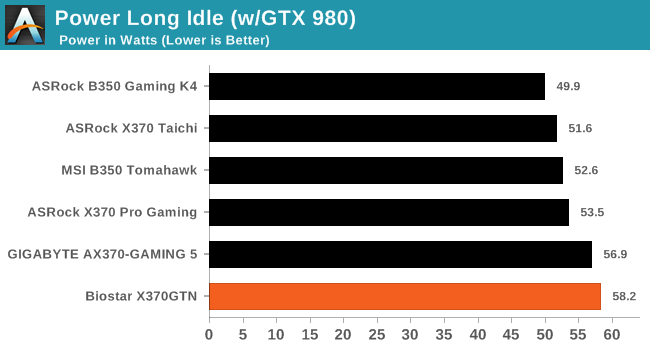
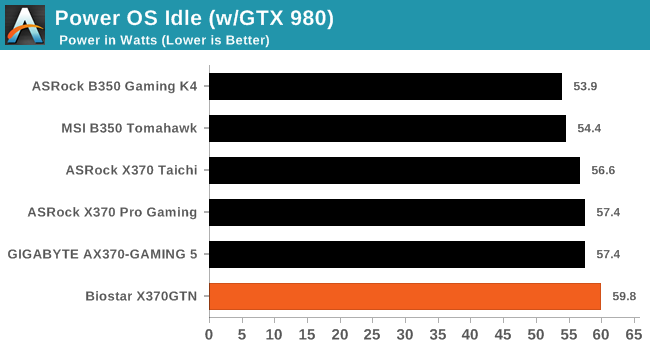
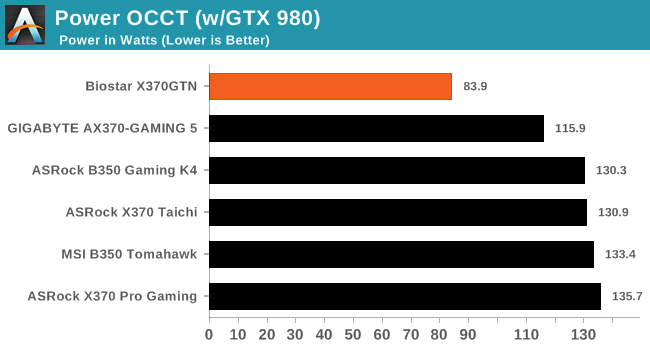
The Biostar X370GTN provided some very interesting power results which does indeed make things look a little odd. In all 3 of our power tests, the X370GTN provides results at different ends of the spectrum, with the power being high at idle, but very low at load. With smaller boards there might be inefficiencies leading to high power at low loads, and lower overall power at load, but this much of a difference was somewhat surprising/alarming. We confirmed the data a couple of times, especially given the 65W processor at hand and the system pulling 185W when overclocked. We're redoing the numbers again, and will update.
Non UEFI POST Time
Different motherboards have different POST sequences before an operating system is initialized. A lot of this is dependent on the board itself, and POST boot time is determined by the controllers on board (and the sequence of how those extras are organized). As part of our testing, we look at the POST Boot Time using a stopwatch. This is the time from pressing the ON button on the computer to when Windows starts loading. (We discount Windows loading as it is highly variable given Windows specific features.)
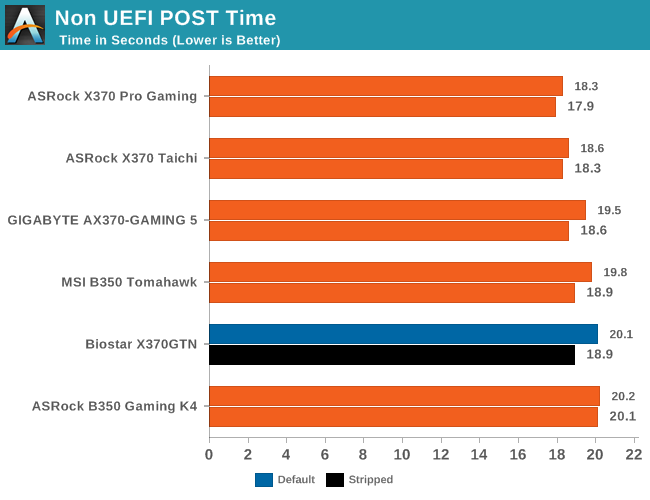
The Biostar X370GTN is marginally one of the slowest boards in our Non UEFI post time testing and disabling all the available controllers/fluff shaved a mere second or so off post times.
Rightmark Audio Analyzer 6.2.5
Rightmark:AA indicates how well the sound system is built and isolated from electrical interference (either internally or externally). For this test we connect the Line Out to the Line In using a short six inch 3.5mm to 3.5mm high-quality jack, turn the OS speaker volume to 100%, and run the Rightmark default test suite at 192 kHz, 24-bit. The OS is tuned to 192 kHz/24-bit input and output, and the Line-In volume is adjusted until we have the best RMAA value in the mini-pretest. We look specifically at the Dynamic Range of the audio codec used on board, as well as the Total Harmonic Distortion + Noise.
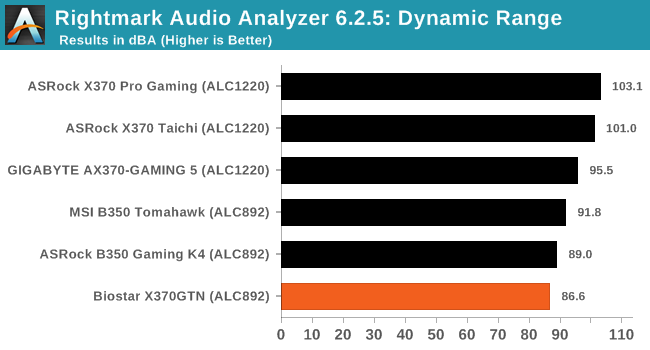
Performance in RMAA does yield some interesting results. Mini-ITX motherboards tend to suffer in audio performance due to electrical interference for the proximity of components. The newer codecs tend to handle this better, but against the other ATX boards we have tested, the ALC892 in the Biostar sits at the bottom of our comparison.
DPC Latency
Deferred Procedure Call latency is a way in which Windows handles interrupt servicing. In order to wait for a processor to acknowledge the request, the system will queue all interrupt requests by priority. Critical interrupts will be handled as soon as possible, whereas lesser priority requests such as audio will be further down the line. If the audio device requires data, it will have to wait until the request is processed before the buffer is filled.
If the device drivers of higher priority components in a system are poorly implemented, this can cause delays in request scheduling and process time. This can lead to an empty audio buffer and characteristic audible pauses, pops and clicks. The DPC latency checker measures how much time is taken processing DPCs from driver invocation. The lower the value will result in better audio transfer at smaller buffer sizes. Results are measured in microseconds.

Not all motherboard manufacturers optimize their motherboards for DPC latency, and the Biostar X370GTN is no different here. Although it looks like a poor result, this is more than acceptable for a board of this caliber and size.










31 Comments
View All Comments
Brother Ali - Thursday, October 26, 2017 - link
I have the asrock itx B350 and a 1600. I have my voltage set to 1.375 in the bios. In HWMonitor its .384V-1.392V; stays at 1.392V consistently.austinsguitar - Wednesday, October 25, 2017 - link
this sort of thing is why itx is bad for high wattage components. you cant expect much from this gigabyte board. the cooling on the vrm is awful. horindusly bad. these motherboards should not be overclocked too high for the long run. if you look up guides on the design of them they all miss the mark in components and cooling. so all in all. mini itx, dont do it on ryzen. atleast for overclocking long term. your problem is not new.xrror - Wednesday, October 25, 2017 - link
This is a Biostar board, not Gigabyte.Dr. Swag - Monday, October 23, 2017 - link
It would be great to see a better look into the vrms (efficiency, mosfet temps, etc.). AM4 VRMs seem to have been a hot topic (pun intended) since Ryzen launched due to boards with pretty budget vrms being able to run with 8 core CPUs. I would like a more in depth look into the vrms of each board to see how worthy all of them are.u.of.ipod - Monday, October 23, 2017 - link
Always happy to see small form factor reviews!!!Lurpak - Monday, October 23, 2017 - link
I have had this motherboard for since June and to be honest, I can not recommend it. If you are running an old version of the BIOS the motherboard is so unstable that it crashes all the time. My first unit died on me during a BIOS update (there's no backup BIOS), but luckily I was able to update the BIOS on the second one.Currently my problems are with memory where the motherboard sometimes fail to boot at XMP settings, which then requires me to set them again and hope that it works. My memory problems could be down to AGESA and seems to have been more stable since I got a BIOS update with AGESA 1.0.0.6b, but it still fails once in a while.
twnznz - Tuesday, October 24, 2017 - link
Does yours power cycle 5x when it fails a boot as well? I'm rolling AGESA 1.0.0.6b as well, Trident Z F4-3200C14D-16GTZR 14-14-14-34, with XMP settings. I've wound the mem voltage up to meet 1.35vLurpak - Tuesday, October 24, 2017 - link
Yeah, that is exactly what it does. The 5 times power cycle is a fail-safe designed to catch errors in BIOS settings. From what I have read the problem with the board seems to be, that it cannot get the correct voltage for the RAM and therefore fails boot. I am running G.Skill Ripjaws V, which runs at higher latencies.Paull29724 - Sunday, November 19, 2017 - link
I just got this motherboard, whats your system config?jrs77 - Monday, October 23, 2017 - link
mITX-boards are allways nice, but without an APU a mITX-board is pretty much useless for the majority of people, who would want to build a silent and powerefficient HTPC or SFF-office station with these.